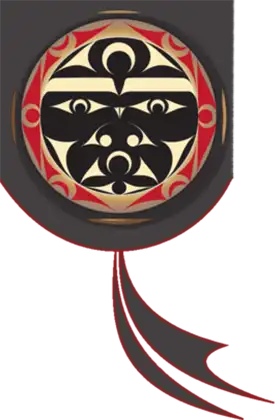Whea-kadim – William Shelton
Whea-kadim – William Shelton
1868-1938

William Shelton was born in 1868 at Brown’s Point (now Sandy Point) on Whidbey Island. He was an advocate for Native Americans, a storyteller, and a prolific carver of story poles which tell the stories of his tribal legends. Growing up, Shelton listened to the elders that were present at the Point Elliott treaty signing in 1855 at Mukilteo. At age 18, Shelton ran away from home to attend the Tulalip Mission School where he was taught to read and write. He remained there for three years until he was given a position at the Tulalip Indian Agency.
William Shelton was a cultural leader of the Tulalip Tribes, spending much of his life attempting to bridge the divide between regional Indians and whites through traditional storytelling and art. Shelton gained an understanding of his own native culture through family teachings and by learning from many of his tribal elders. He was adept at working with Bureau of Indian Affairs and city government officials, gaining their respect and support.
Shelton spent years mastering the art of wood carving to create story poles through which he shared many of his tribes’ cultural teachings. To accompany one of his carved poles, Shelton wrote a booklet, “Indian Totem Legends of the North-west Coast Country,“ published in 1914, by the Chilocco Indian school, in Oklahoma,” In that booklet, he saw a need for understanding between the races;

“I saw right there that the two races were pretty near alike, only that our people don’t understand the English language and the ruling of the good friends. There is a broken link between my race and the white people. So, I thought I better look back and talk to the older people that are living and try to explain our history by getting their totems and carve them out on the pole like the way it used to be years ago. So, I went around gathering the old Indians and talking to them in the genuine Indian language I learned when I was young. I used this language to make them understand why I wanted their totems carved on the pole to show our history-so our good friends could see the ruling foundation of all Indians around the sound.
We had a regular meeting, and the members of the different tribes talked about the totems that were going to be carved on the pole. The old friends of mine understood, and each one of them got up and made a speech, telling how nice it was going to be to have their totems carved out so the people would see the Indian beliefs. It shows from the pole that they understood, and shows that they had good sense to be willing to do that, for that is the best we could do, as it would show out so everybody could see. That is how you can see the totem pole that I carved out with the courage of the older Indians that are living to show our young children that are now in school, who never saw anything like that before, for these totems and medicine men have dropped for several years. They are never seen, for the Indians thought that the best they could do was to drop all their ways, or else never get along with the white people. That was their belief.”

He was an emissary between the Snohomish people and the United States government. Shelton went on to write a letter to the Secretary of the Interior asking for permission to build a longhouse. Shelton won permission a change from previous administrations that tried to weaken tribal cultures.
Shelton’s title of chief was as Tulalip Chief of Police but his works made him a cultural leader. So important was he to the preservation of Tulalip tribal tradition that upon his death, many feared the culture would vanish with him. Instead his accomplishments served as the bridge for following generations who found new ways to continue his work.
Shelton’s life and work are a testament to the importance of preserving indigenous cultures and traditions. His story poles, which are still displayed in various locations in the Pacific Northwest, are a testament to his legacy. They are a reminder of the rich history and culture of the Tulalip Tribes and the importance of preserving it for future generations.
Some of the Stories he told were:
Lifting up the Sky
Indian Totem Legends of the North-west Coast Country
